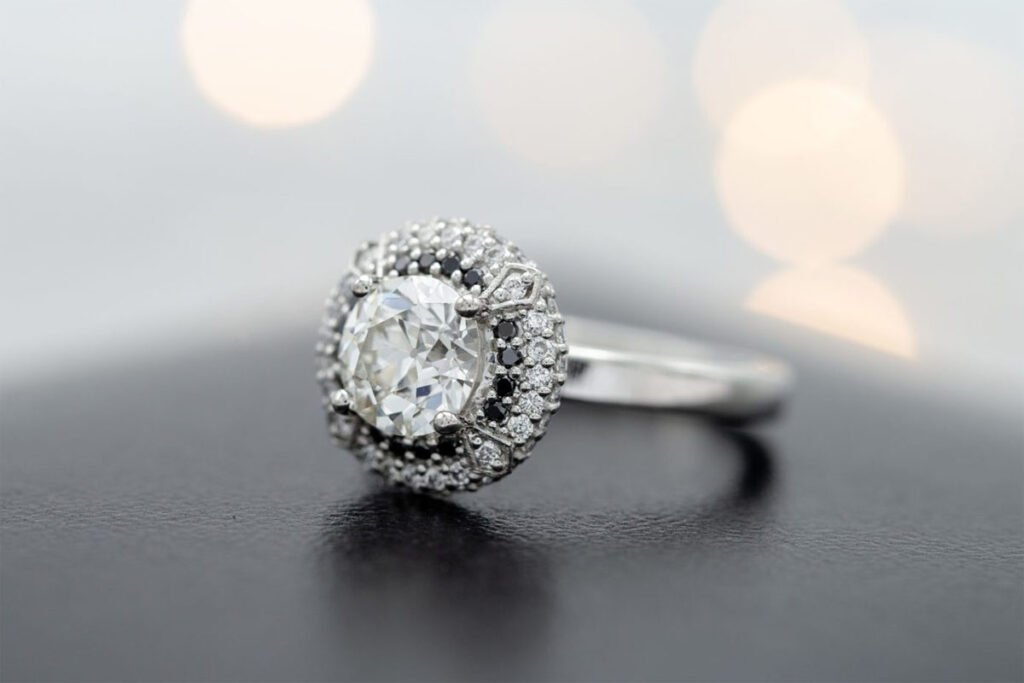If someone asks you “how to buy old European cut diamonds,” you will probably be shocked as if stung by an electric eel. In these rapidly-changing times, when the latest becomes passé the following day, who in his right mind would be looking for an old European cut diamond?
But the question is valid. There is such a thing as an old European cut diamond. And people with a flair for sentimental, antique, or vintage things love them.
But before digging right in, you would have a clearer understanding of the subject if you know the evolution of the brilliant cut diamonds.
Evolution of the Brilliant Cut
When diamonds were discovered in South Africa in 1876, gem-cutting was in its infancy, and the tools used to cut them as they are cut today. It can be likened to how primitive man made his first tool from flint rocks. So the first cut was the…
Old-mine cut
The old-mine cut was the antique but prevalent cut that dominated the scene between the mid-1800s and the early 1900s.
Its most notable features were its bulky, uneven shape, visible culet, and tiny table. It had plenty of unique elements that remain unique and different.
There being nothing else to offer, the old-mine cut was very popular during its time. It looks Victorian and is still very much in demand today.
Old European cut
The old European cut is a round diamond developed in Europe (of course) and was the diamond of choice between 1890 to 1930. They were very trendy then and gained much popularity during the Art Deco period.
Though it has 58 facets it looked drastically different from the round brilliant diamonds in the market today. It had better dispersion of multi-colored fire within the stone.
Round brilliant
The round brilliant cut made its way after the painstaking work of Marcel Tolkowsky, a Belgian-born gemologist, and mathematician.
Through long years of study, he came up with a technique for cutting diamonds to maximize their brilliance and luster. The result was the round brilliant, which was introduced to the market in 1919.
Differences between the three:
Diamonds cut before the 1890s were called the old mine cut. After that, they were called the old European cut.
Old Mine Cut vs. Old European
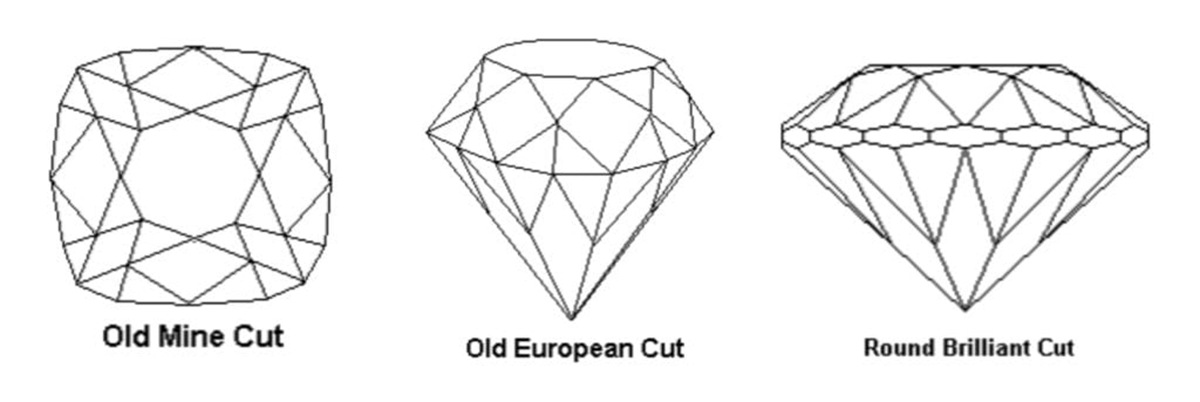
- Age: old mine cut diamonds were older by about 100 years. Old mine cut diamonds are abundant in Georgian and Victorian-era jewelry.
- Shape: old mine cut diamonds were square in shape while the old European cut was round with curved edges and looks like a modern cushion cut diamond.
- Culet: both have culets but those in the old mine were larger. The culets were so obvious they can be seen through the table without magnification.
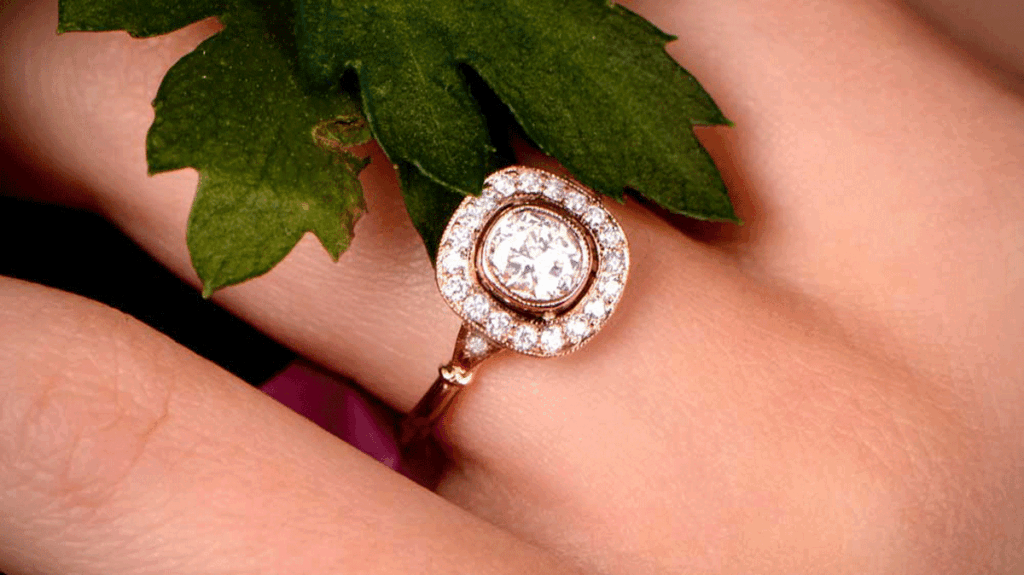
- Proportions: they have different proportions compared to the old European, which was cut after the first bruting machine was developed in 1874. This made it possible to have smaller and more precise facets.
- Fire: the old mine cut had larger facets than the old European cut and, thus, had a more intense fire and color. Old mine cut also showed a different contrast pattern compared to diamonds of other cut types.
Gems cut until the 1930s were old European cut. After that, they became round brilliant, like the one in this Mappin Webb review
Old European vs. Round Cut
- Table size: old European cut diamonds have small tables—roughly 53% to 38% of the diamond’s total diameter. Round cut diamonds have larger tables, which can range from 52% to 60%.
- Facet shape: Although old European cut diamonds and round diamonds have a similar number of facets (58, or 57 if the culet isn’t counted), the facets of each diamond cut are different in shape. Old Europeans have larger triangular facets, those of the round brilliant is thinner. The old European also has very long lower-half facets—around 60% of the diamond’s total depth.
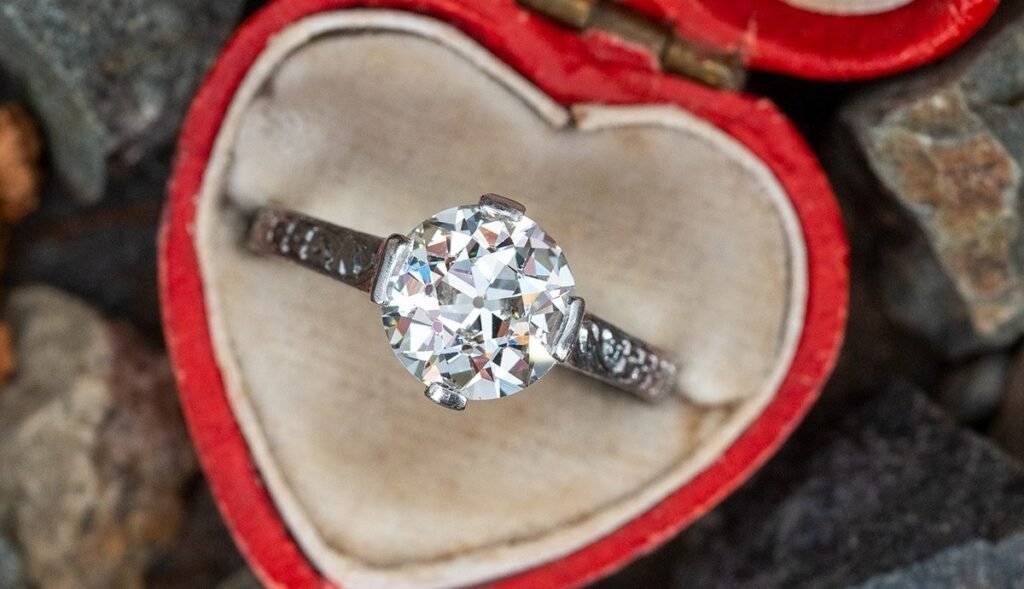
- Culet size: old European cut diamonds have large culets that are visible from the table of the diamond. In the round brilliant, the culet size varies. In fact, if you are shopping for a round brilliant, look for one with no culet.
- Girdle finishing: typical of antique jewelry, old European cut diamonds had bruted (unpolished), or frosted girdles. On the other hand, girdles of round brilliant cut diamonds are mostly faceted.
- Precision and symmetry: there were no sophisticated tools during the time of the old European cut diamond, and they were cut by hand so they were not so symmetrically and precisely cut. Modern-day round brilliant diamond cutters use the most sophisticated cutting, grinding, and polishing tools.
- Color and brilliance: old European cut diamonds emphasized carat size and color while the round brilliant has better brilliance, sparkle, and fire.
Everything You Need to Know About the Old European Cut
If you’re fond of shopping for vintage rings, it is certain that you have come across the term old European cut diamonds.
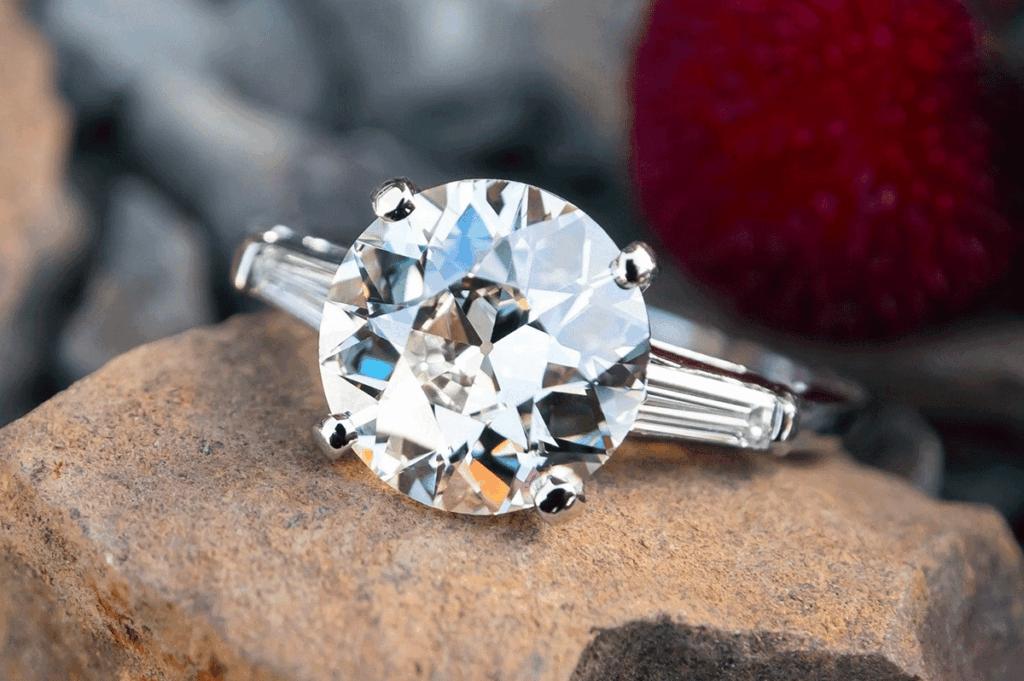
The old European cut diamond was first crafted in Europe in the 1890s. They were extremely popular among all classes of people up until the early 1900s. With the advancements in cutting techniques and tools, they experienced a demise by the 1930s—when round brilliant cut came into the market.
So if you’re curious and want to know when did old European cut diamonds stop? Officially, gem cutters stopped making them in 1930.
Carat weight vs. brilliance
Old European cut diamonds were large and bulky because they were cut for their carat weight rather than brilliance. They were less sparkly compared to the modern brilliant cut. Though they have 58 facets, they don’t display the same sparkle and brilliance as the current diamonds on the market.
Each diamond has a unique and individual quality in them. This is because each was manually cut and polished under candlelight. The cutting technology was in its infancy and there were no tools to allow for a degree of uniformity. Hence, no two diamonds are perfectly alike. Despite this, being hand-made, they exuded a high degree of charm.
Visual characteristics of the old European cut
Old European cut diamonds can easily be distinguished by their large facets and a small table. They are easily recognizable by the small circle at the center of the table. This is caused by its large culet (the facet at the bottom of the diamond). This characteristic allowed more light to escape through the bottom of the diamond.
It must be noted though that not all diamonds—especially the modern ones—have culets. They have sharp points at the bottom to reflect light.
Another distinguishing feature of old European cut diamonds is the smaller table and a higher crown. And since they were hand-made, their symmetry is poor.
So do old European cut diamonds sparkle?
Old European cut diamonds were mined for their carat weight, not for sparkle and brilliance. But still, they sparkle, albeit not as much as the modern-day round brilliant cut.
What are the best settings for old European cut diamond
What is the best setting for old European cut diamond. Old European cut diamonds are unique and rare. To emphasize this characteristic, it is important to set it according to their specific period. Thus, look for the following setting styles when shopping for this type of diamond cut.
- Edwardian style – very intricate metalwork, almost like lace. White gold or platinum gives way to yellow gold.
- Victorian style – the diamond is set in yellow gold, rose gold, such as the one in this Fink’s review, or silver. This style often suits rose cut, old mine cut, and marquise cut.
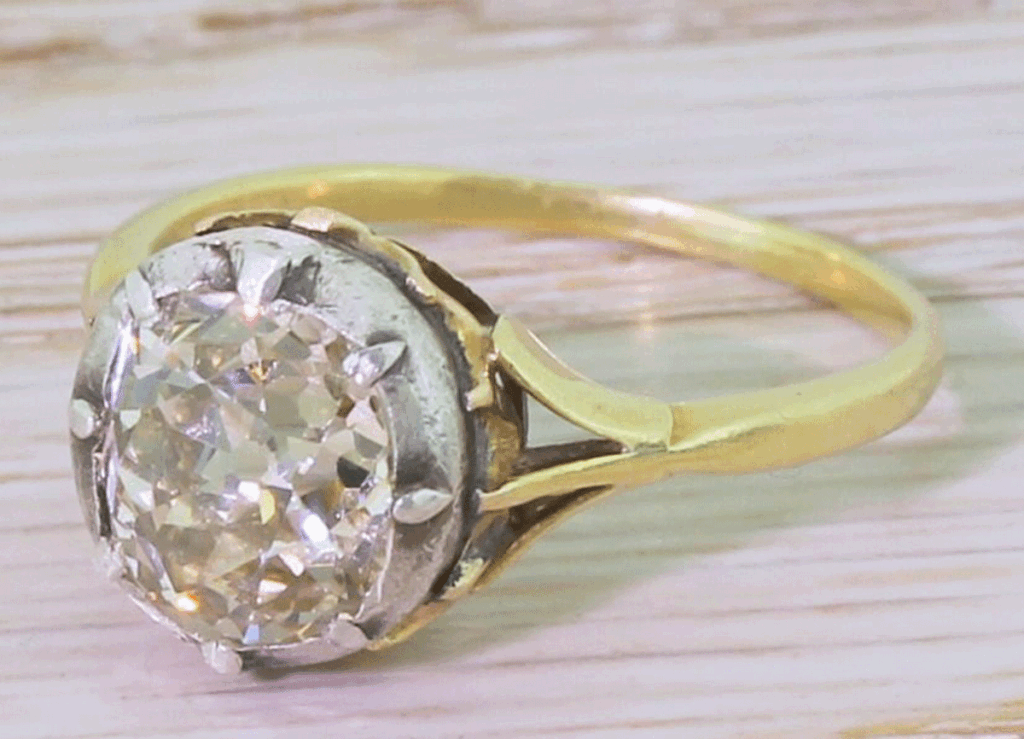
- Art Deco style – setting crafted between 1920-1935. It is distinguished by its angular and symmetrical look.
- Filigree style – this involves arranging threads and beads of precious metal into an elaborate lace-like design. Sometimes engagement rings in filigree setting style are engraved or contain small accent stones of diamond or other gemstones.
- Cathedral style – this involves arching lines that rise on each side of the center stone, lifting it off the base of the ring.
Are Old Cut Diamonds Worth More?
While there are calculators for all modern-day diamond cuts, there is no old European cut diamond value calculator. At any rate, they are generally cheaper compared to other diamond cuts. This is due to the fact that they are practically used “direct from the mines.” They were cut by hand using whatever tool was available during the time. In other words, they didn’t require any additional cost to introduce them to the market.
But just like any other diamond, their prices can vary according to color, clarity, and carat weight. And just like any antique diamond, an old European would cost about 20% less compared to new diamond cuts of the same carat weight, color, and clarity.
The above is not a hard-and-fast rule because of the increasing popularity of antique diamonds. Some excellent old European cuts could fetch the same prices per carat as the modern cuts. In some cases, they may even be worth more—especially those which are beautifully cut or have cultural or historical value.
How to Buy Old European Cut Diamonds
Pros
- Unique and one-of-a-kind – this is because they were cut, measured, and polished by hand. No stone is exactly the same. This property would resonate with people who don’t like copy-cats around them or to be taken as one.
- Impressive inner fire – though not as brilliant as the round cut, they have their own inner fire.
- Good value for money – like any other antique diamond, they are often cheaper than modern diamonds, giving them a good value for your money.
Cons
- Limited options and supply – the last old European cut diamond was made in the 1930s, so you can expect that they are extremely rare. Even if you can find one, it may not be of the right carat weight, clarity, or color you are looking for.
- Imperfect cut quality – old European cut diamonds were made prior to the entry of modern cutting machines, as such, they were not as precisely cut as modern-day round brilliant.
- No GIA cut grades – since they vary from one stone to the other, the GIA doesn’t include the old European cut in its grading platform.
Tips on buying old European cut diamonds
If you have decided to go for an old European, keep these things in mind:
- Focus on personal preference, not the certificate.
While it is necessary to ask for a certificate for modern-day diamonds, there is no such thing for old European cuts. So focus on personal preference when buying one.
Focus on something that is attractive to your eyes. Feel its sense of character; its essence that moves your emotions.
- Pair it with a vintage setting.
Pair it with the right setting (discussed above). Remember you are buying something antique. It should look like its age or era on your finger.
- Consider a yellow or rose gold setting
Old European cuts have fairly low color grades such as J, K, L, or M. This is due to the fact that they were mined from areas with warmer-colored stones.
Another reason is that they have been recut through the years into various cut types. This makes them look more attractive in colored metal like yellow gold. Colored metals are also better in period-appropriate and vintage-looking engagement rings.
Are Old European Cut Diamonds for You?
Old European cut diamonds are vintage stones cut almost a century ago. Over the years, the technology and skill of cutting diamonds have reached the Triple X level in quality. So, are old cut diamonds worth less now now than before?
Just like any other diamond shape and cut, the value of old cut diamonds varies based on the GIA’s criteria of color, carat, clarity, and the intrinsic beauty of the stone. Considering all these, old mine cut diamonds are around 10% to 15% cheaper than old European cut.
Now that you know how to buy old European cut diamonds, you might be interested in other diamond cuts, check out our post, “Choose Your Cut: Comparing Emerald Cut vs Radiant Cut Diamonds.”
